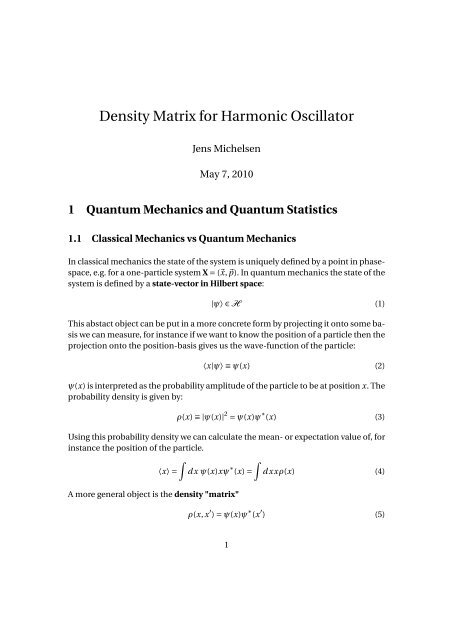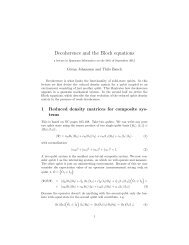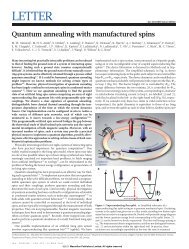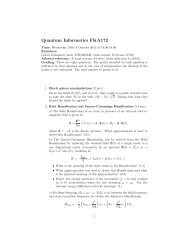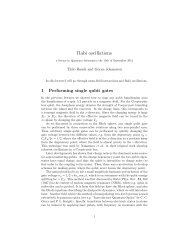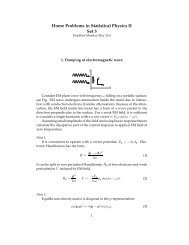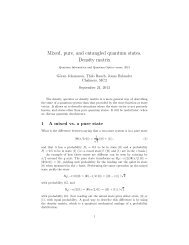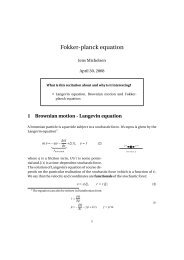Density Matrix for Harmonic Oscillator
Density Matrix for Harmonic Oscillator
Density Matrix for Harmonic Oscillator
You also want an ePaper? Increase the reach of your titles
YUMPU automatically turns print PDFs into web optimized ePapers that Google loves.
<strong>Density</strong> <strong>Matrix</strong> <strong>for</strong> <strong>Harmonic</strong> <strong>Oscillator</strong>Jens MichelsenMay 7, 20101 Quantum Mechanics and Quantum Statistics1.1 Classical Mechanics vs Quantum MechanicsIn classical mechanics the state of the system is uniquely defined by a point in phasespace,e.g. <strong>for</strong> a one-particle system X = (⃗x, ⃗p). In quantum mechanics the state of thesystem is defined by a state-vector in Hilbert space:|ψ〉 ∈ H (1)This abstact object can be put in a more concrete <strong>for</strong>m by projecting it onto some basiswe can measure, <strong>for</strong> instance if we want to know the position of a particle then theprojection onto the position-basis gives us the wave-function of the particle:〈x|ψ〉 ≡ ψ(x) (2)ψ(x) is interpreted as the probability amplitude of the particle to be at position x. Theprobability density is given by:ρ(x) ≡ |ψ(x)| 2 = ψ(x)ψ ∗ (x) (3)Using this probability density we can calculate the mean- or expectation value of, <strong>for</strong>instance the position of the particle.∫〈x〉 =∫dx ψ(x)xψ ∗ (x) =dxxρ(x) (4)A more general object is the density "matrix"ρ(x, x ′ ) = ψ(x)ψ ∗ (x ′ ) (5)1
More accurately this is the density matrix in position-basis 1 .With this density matrix we can evaluate the expectation value of the momentum 2p = −iħ ∂∂x : ∫〈p〉 =(dx −iħ ∂ ) ∫∂x ψ(x) ψ ∗ (x) =(dx −iħ ∂ )ρ(x, x ′ ) ∣ ∂xx ′ =x(6)Note that ρ(x) = ρ(x, x).From the time-dependant Schrödinger eq. and its complex conjugate:i∂ t ψ(x) = Ĥψ(x), −i∂ t ψ ∗ (x) = ψ ∗ (x)Ĥ (7)we find the equation of motion <strong>for</strong> the density matrixi∂ t ρ(x, x ′ ) = ( i∂ t ψ(x) ) ψ ∗ (x ′ ) + ψ(x) ( i∂ t ψ ∗ (x ′ ) )= Ĥρ(x, x ′ ) − ρ(x, x ′ )Ĥ= [Ĥ,ρ](8)which is called the quantum Liouville equation.1.2 Quantum StatisticsSo far we have only discussed the intrinsic randomness due to the probabilistic natureof QM. In general we also have randomness due to initial conditions etc. We canimagine that our system is in one of many states |ψ n 〉 (or in postion basis ψ n (x)).The statistical average is then to be taken wrt an ensemble of states |ψ n 〉 weighted bysome probability w n :〈x〉 = ∑ w n 〈x〉 ψn = ∑ ∫w n dxψ n (x)xψ ∗ n (x) (9)nnIf we then define a new statistical density matrixρ(x, x ′ ) = ∑ nw n ψ n (x)ψ ∗ n (x′ ) (10)1 The more general <strong>for</strong>m of the density matrix of a pure state is ˆρ = |ψ〉〈ψ| and we can defineaverages as 〈A〉 = Tr(Â ˆρ) = ∫ dx ∫ dx ′ 〈x ′ |Â|x〉〈x|ψ〉〈ψ|x ′ 〉 = ∫ dx ∫ dx ′ A(x ′ , x)ψ(x)ψ ∗ (x ′ ) =∫dx∫dx ′ A(x, x ′ )ρ(x, x ′ ) which <strong>for</strong> Â = ˆx with 〈x ′ | ˆx|x〉 = xδ(x − x ′ ) gives us 〈x〉 = ∫ dxxρ(x, x)2 In the Dirac Bra-Ket notation we have 〈x ′ | ˆp|x〉 = δ(x − x ′ )(−iħ ∂∂x) so that∫〈p〉 = Tr( ˆp ˆρ) =∫dx∫dx ′ 〈x ′ | ˆp|x〉〈x| ˆρ|x ′ 〉 =∫dxdx ′ δ(x−x ′ )(−iħ ∂∂x ρ(x, x′ )) =∫(dx −iħ ∂ )∂x ρ(x, x′ )x ′ =x2
the averages can again be written∫〈x〉 = dx xρ(x, x)∫ (〈p〉 = dx −iħ ∂ )ρ(x, x ′ ) ∣ ∂xx ′ =x(11)The problem then is to determine the statistical density matrix ρ(x, x ′ ) <strong>for</strong> a givensystem. In what follows I will derive the density matrix <strong>for</strong> a <strong>Harmonic</strong> oscillator usingthe derivation due to Feynman:2 <strong>Density</strong> <strong>Matrix</strong> of <strong>Harmonic</strong> <strong>Oscillator</strong> a la FeynmanThe equilibrium density matrix should be one which does not depend on time: ∂ t ρ =0. We then have from the quantum Liouville equation:0 = i∂ t ρ = [H,ρ] (12)we may note that e −βH satisfies this equation and we will take this to be our densitymatrix. How do we find the representation in position basis? Feynman noted that<strong>for</strong>mally you can write− ∂∂β ρ = Hρ (from − ∂∂β e−βH = He −βH )which gives us a differential equation to be solved with the initial conditionswhich in position basis corresponds to(13)β = 0 ⇒ ρ = e −0 H = 1 (14)ρ(x, x ′ ,β = 0) = δ(x − x ′ ) (15)Let’s solve Eq. (13) <strong>for</strong> the <strong>Harmonic</strong> oscillator which in position basis has the HamiltonianH = p22m + mω22 x2 = − ħ2 ∂ 22m ∂x 2 + mω22 x2 (16)Using scaled coordinatesX =√√mωħ x =⇒ ∂∂X = ħmω∂∂x(17)3
in which the Hamiltonian takes the <strong>for</strong>mH = ħω )(− ∂22 ∂X 2 + X 2by defining f = (ħω/2)β we get the nicer looking differential equationwith the initial condition− ∂∂f ρ(X , X ′ , f ) =ρ(X , X ′ , f = 0) = δ(x − x ′ ) = δ((18)(− ∂2∂X 2 + X 2 )ρ(X , X ′ , f ) (19)√ħmω (X − X ′ )) =√ mωħ δ(X − X ′ ) (20)where I used the identity δ(g (y)) = |g ′ (y 0 )| −1 δ(y − y 0 ) where y 0 is a root of f (y).We solve this differential equation similar to how we solved the Fokker-planck equation: by making an ansatz and then comparing coefficients in powers of X .Ansatz: ρ = e −(a(f )X 2 +b(f )X +c(f )) (21)Note that X ′ only enters differential equation as a parameter ⇒ a,b,c may dependon X ′ . The left hand side of Eq. (19) can be writtenLHS: − ∂ρ ( ∂a∂f = ∂f X 2 + ∂b∂f X + ∂c )ρ (22)∂fand the right hand sideRHS:)(− ∂2∂X 2 + X 2 ρ = ∂ [− ∂ ]∂X ∂X ρ + X 2 ρ= ∂ [ ](2aX + b)ρ + X 2 ρ∂X= [ 2a − (2aX + b) 2 + X 2] ρ= [ 2a − 4a 2 X 2 − 4abX − b 2 + X 2] ρPutting it all together we have[ ∂a∂f X 2 + ∂b∂f X + ∂c ]ρ = [ 2a − 4a 2 X 2 − 4abX − b 2 + X 2] ρ (24)∂fCancelling ρ on both sides and comparing powers of X gives us three equations:X 2 :X 1 :X 0 :∂a∂f = 1 − 4a2 ⇒ a = 1 2 coth2f∂b∂f = −4ab ⇒ b = Asinh2f∂c∂f = 2a − b2 ⇒ c = 1 2 ln[ sinh2f ] + A24(23)2 coth2f − ln[B] (25)
The last term can be rewritten into the <strong>for</strong>m[ ]c = A22 coth2f − ln B√sinh2fInserting this into the Ansatz. Eq. (21):ρ = e − 1 2=[ ][]coth2f X 2 + 2AXsinh2f +A2 coth2fe ln Bsinh2f[]coth2f X 2 + 2AXsinh2f +A2 coth2fB√sinh2fe − 1 2(26)(27)=B√sinh2fe − 12sinh2f [cosh2f (X 2 +A 2 )+2AX ]Now we remember the initial condition ρ(f = 0) = mω/ħδ(X −X ′ ), and look at smallf:{cosh2f → 1f → 0 ⇒(28)sinh2f → 2fwhich means that in this limit we getρ ∼√ B e − 14f [X 2 +2AX +A 2 ] B = √ e − 14f (X +A)2 (29)2f 2fThis becomes a delta function as f → 0 if we take A = −X ′ with the normalizationB = mω/2πħ. The density matrix then takes the <strong>for</strong>m:√mωρ(X , X ′ 1, f ) =2πħsinh2f e− 2sinh2f [cosh2f (X 2 +X ′2 )−2X X ′ ](30)In the original variables x = ħ/mωX and β = (2/ħω)f we get the final solution√mωρ(x, x ′ mω,β) =2πħsinh2f e− 2ħsinh(βħω)[cosh2f (x 2 +x ′2 )−2xx ′ ](31)From this you are to calculate the mean square deviations <strong>for</strong> x, p.3 <strong>Density</strong> matrix in energy-eigenbasisI will now calculate the averages 〈x〉, 〈x 2 〉, 〈p〉 and 〈p 2 〉 by he use of ladder operators.This method is generally simpler because the density matrix has a much simpler <strong>for</strong>min energy-eigenbasis than in position basis:ρ nn ′ = e −βE nδ nn ′ (32)5
The average value of some operator  can in this basis be written〈A〉 = 1 Z Tr[Âρ] = 1 ∑〈ψ n |Âψ n 〉e −βE n(33)Zwhere |ψ n 〉 is an energy eigenstate: H|ψ n 〉 = E n |ψ n 〉. For example, we haven〈x〉 = 1 Z Tr[xρ] = 1 ∑〈ψ n |xψ n 〉e −βE nZ n〈p〉 = 1 Z Tr[pρ] = 1 ∑〈ψ n |pψ n 〉e −βE nZn(34)In order to evaluate the averages we need to know the matrix elements 〈ψ n |xψ n 〉 and〈ψ n |pψ n 〉. This is where the ladder operators come in.Starting from the Hamiltonian:ħω(− ∂2)2 ∂X 2 + X 2 = ħω 2(K 2 + X 2) (35)where we define K = −i ∂∂X. From the commutation relations [x, p] = iħ we find[X ,K ] = i (36)The ladder operators are defined asa = 1 2(X + iK )a † = 1 2(X − iK )⇐⇒X = 1 ) (a † + a2K = i ) (37)(a † − a2Inserting this into the Hamiltonian:H = ħω [− 1 ()a † a † − a † a − aa † + aa + 1 () ]a † a + a † a + aa † + aa = ħω [a † a + aa †]2 222(38)Here we need to keep track of the ordering because a † and a do not commute sinceX ,K do not commute, in fact:[X ,K ] = i =⇒ [a, a † ] = aa † − a † a = 1 (39)Using this in the Hamiltonian we get(H = ħω a † a + 1 )2(40)6
Since ˆn ≡ a † a is a Hermitian operator it has a set of complete and orthogonal eigenstates|n〉.ˆn|n〉 = a † a|n〉 = n|n〉 (41)Note that if |n〉 is an eigenstate of ˆn = a † a then |n〉 is also eigenstate of H:note that this implies that in the old notationWhy are a, a † called "ladder operators"?Consider the stateH|n〉 = E n |n〉, E n = ħω(n + 1 2 ) (42)=⇒ |ψ n 〉 = |n〉 (43)|φ + 〉 = a † |n〉 (44)I will claim that this is also an eigenstate of ˆn. To show this we act with ˆn on thisstate:( )ˆn|φ + 〉 = a † a a † |n〉 = a † (aa † ) |n〉} {{ }=a † a+1= a † (n + 1)|n〉 = (n + 1)a † (45)|n〉= (n + 1)|φ + 〉we thus see that, upto normalization we havesimilarly we can show thata † |n〉 ∼ |n + 1〉 (46)a|n〉 ∼ |n − 1〉 (47)This means that a † raises the eigenvalue n by one integer, while a lowers the eigenvalueby one integer. By applying a † we can thus climb the "ladder" of eigenstates.E.g. starting from a fiducial state |0〉 we can obtain all other states:|n〉 ∼ (a † ) n |0〉 (48)3.1 AveragesSince the states |n〉 are orthogonal to each other we have that〈n|a † n〉 ∼ 〈n|n + 1〉 = 0〈n|an〉 ∼ 〈n|n − 1〉 = 0(49)7
and it follows that〈a † 〉 = 1 Z Tr[a† ρ] = 0〈a〉 = 1 Z Tr[aρ] = 0 (50)Due to this we have a quite simple expression <strong>for</strong> the average position〈X 〉 = 1 )(〈a † 〉 + 〈a〉 = 02〈K 〉 = i)(〈a † 〉 − 〈a〉 = 02(51)and similarly <strong>for</strong> the mean square deviations〈X 2 〉 = 1 2 〈(a† + a) 2 〉 = 1 ()〈a † a † 〉 + 〈a † a〉 + 〈aa † 〉 + 〈aa〉2〈K 2 〉 = − 1 2 〈(a† − a) 2 〉 = 1 () (52)−〈a † a † 〉 + 〈a † a〉 + 〈aa † 〉 − 〈aa〉2because of 〈n|a † a † n〉 = 0 and 〈n|aan〉 = 0 we have only〈X 2 〉 = 〈K 2 〉 = 〈a † a〉 + 〈aa † 〉 (53)and it remains to evaluate 〈a † a〉 and 〈aa † 〉. To do this I shall use two things.1. Baker-Campbell-Haussdorf theorem e βH ae −βH = ae −βħω2. Cyclic property of the trace Tr[ABC ] = Tr[BC A] = Tr[C AB]Using these we can find the following relationship:〈a † a〉 = Z −1 Tr[a † aρ] = Z −1 Tr[a † ae −βH ] = Z −1 Tr[a † e} −βH {{e βH}ae −βH ]=I= Z −1 Tr[a † e −βH e} βH ae{{ −βH}] = Z −1 Tr[a † e −βH a]e −βħω = Z −1 Tr[aa † e −βH ]e −βħωae −βħω= 〈aa † 〉e −βħω (54)Now using the commutation relation [a, a † ] = 1:1 = 〈[a, a † ]〉 = 〈aa † 〉 − 〈a † a〉 = 〈a † a〉(e βħω − 1) (55)or〈a † a〉 = 1/(e βħω − 1) and 〈aa † 〉 = −1/(e −βħω − 1) (56)8
We now have all the tools to calculate the mean variance from Eq. (53):〈X 2 〉 = 〈K 2 〉 = 1 ()12 e βħω − 1 − 1e −βħω = 1 cosh(βħω/2)− 1 2 sinh(βħω/2) = 1 coth(βħω/2) (57)2Going back to the unscaled coordinates we get〈x 2 〉 = ħmω 〈X 2 〉 =ħ ( ) βħω2mω coth 2〈p 2 〉 = ħ 2 mωħ 〈K 2 〉 = ħmω ( ) (58)βħωcoth229


